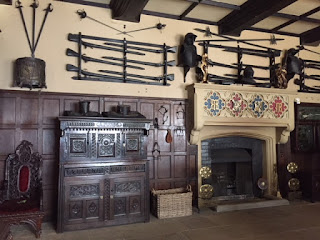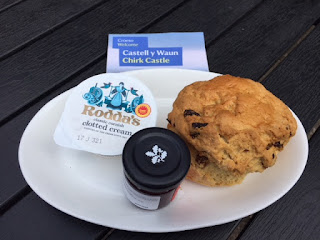Chirk Castle near Wrexham was built by Roger Mortimer in 1295. To prepare for my visit I read a book about Roger Mortimer, but unfortunately for me the book turned out to be about a different Roger Mortimer. It didn't really matter, however, because a) the book was quite good and b) the Rog in the book was the nephew of the Chirk Rog and they got into all sorts of bother together, so it wasn't a totally wasted read.
In fact, neither of the Roger Mortimers was what you'd call 'nice' - here's a quick summary of Chirk's various owners and associated types:
1. Roger Mortimer of Chirk
3. Subsequent owners
Chirk then passed through many hands, back and forth as the turbulent times changed people's fortunes. The Fitzalans, Sir William Stanley, Robert Dudley, the Crown all owned Chirk at some point, until it was sold to a Thomas Myddleton in 1595.
The Myddletons were very good at two things; 1) making money and 2) staying on the right side of the political fence. Thanks to this, they managed to hang on to Chirk until it was passed to the National Trust in 1981. Guy Myddleton moved out in 2004, although he still has rooms in the castle.
4. Chirk Castle itself
Chirk Castle is great, because it offers a bit of everything:
The gardens were also lovely:
5. The Chirk Scone
But I know you're all wanting me to move on from grisly deaths and adulterous affairs and get on with the all-important Chirk scone. It had been three months since my last scone mission (to the Longshaw Estate) and I desperately needed a corker to get myself back on track with this National Trust Scone Odyssey. Chirk was mission number 164 and I still have around 80 properties to go - send positive thoughts.
The Chirk scone was like the castle itself - hefty. And that's always a slight concern to me, as I've had a couple of dry scones where I've eaten half, looked down at my plate, and realised with something approaching horror that I still have half to go.
But fear not, readers, as the Chirk scone was excellent - it was fresh as anything with a slighly crunchy exterior and fluffiness within. Top marks.
The tea room at Chirk should also get a mention in dispatches - it's in the actual castle and so you can sit outside in the courtyard with your scone and reminisce about Chirk Roger galloping home having successfully murdered a few people.
I will end by advising caution if you do decide to read The Greatest Traitor - The Life of Sir Roger Mortimer Ruler of England 1327-1330. Avoid Chapter 12 before bedtime, or at all if you are very squeamish. It goes into great detail about Edward II's death by red hot poker - great, great detail, in fact; detail that you didn't think possible. It's a good read though and always good to know a bit of background before you visit the NT! Even if it's not about the right person.
Chirk Castle: 5 out of 5
In fact, neither of the Roger Mortimers was what you'd call 'nice' - here's a quick summary of Chirk's various owners and associated types:
1. Roger Mortimer of Chirk
- Roger was a Marcher Lord - that is, one of the noblemen appointed by Edward I to protect the border with Wales, which was a pretty lively place at the time
- When Llywelyn ap Gruffydd ap Madoc, Lord of North Powys, died, he left two small boys as heirs - they were put under Roger's guardianship
- However, both boys were killed - they were pulled from the River Dee in 1281. Was Roger involved? Well, their deaths certainly worked in the king's favour and Roger was granted their lands, so my money is on yes.
- Roger also helped to kill Llywelyn ap Gruffydd, the first and last Prince of Wales, in 1282 in an ambush
- In the 1320s, Uncle Roger joined his nephew and other noblemen in a revolt against Edward II because of the king's relationship with Hugh Despenser the Younger. This didn't end well...
- ...because the revolt failed and the two Rogers were imprisoned in the Tower of London
- Nephew Roger escaped and made it to France where he eventually joined forces with Queen Isabella, wife of Edward II
- Isabella had had enough of her husband and Hugh Despenser and had returned to her homeland
- Once she got her son, the future Edward III, to France as well then it was game on for her to raise an army with Roger (who she was now in a relationship with) and invade to overthrow her husband
- They succeeded in their mission - Edward II was deposed in 1327 and Hugh Despenser met a predictably grisly end
- However, his grisly end, being hung, drawn and quartered, was out-grisled by the reputed death of Edward II, who was apparently murdered at Berkeley Castle through the use of a red hot poker...I'll spare you the detail as this is a family publication
- Roger the nephew then basically ruled England with Isabella until Edward III came of age - by all accounts the power went to Roger's head and he turned into a ruthless, paranoid despot
- Ed came of age and did exactly what presumably everyone except Roger expected him to do - he had Roger executed.
3. Subsequent owners
Chirk then passed through many hands, back and forth as the turbulent times changed people's fortunes. The Fitzalans, Sir William Stanley, Robert Dudley, the Crown all owned Chirk at some point, until it was sold to a Thomas Myddleton in 1595.
The Myddletons were very good at two things; 1) making money and 2) staying on the right side of the political fence. Thanks to this, they managed to hang on to Chirk until it was passed to the National Trust in 1981. Guy Myddleton moved out in 2004, although he still has rooms in the castle.
4. Chirk Castle itself
Chirk Castle is great, because it offers a bit of everything:
- The West Range is the only medieval part to survive and the various rooms look very medieval indeed - you can really imagine how cold castle life must have been
- The North Range is very unusual - The Cromwell Hall looks ancient but it was actually created in the 1840s by Augustus Pugin, the Gothic Revival enthusiast better known for designing the tower that we all mistakenly call Big Ben
- You then walk through to the Grand Staircase designed by Joseph Turner in the 1770s - it's neoclassical in style so it looks much newer than the Cromwell Hall even though it pre-dates it
The gardens were also lovely:
5. The Chirk Scone
But I know you're all wanting me to move on from grisly deaths and adulterous affairs and get on with the all-important Chirk scone. It had been three months since my last scone mission (to the Longshaw Estate) and I desperately needed a corker to get myself back on track with this National Trust Scone Odyssey. Chirk was mission number 164 and I still have around 80 properties to go - send positive thoughts.
The Chirk scone was like the castle itself - hefty. And that's always a slight concern to me, as I've had a couple of dry scones where I've eaten half, looked down at my plate, and realised with something approaching horror that I still have half to go.
But fear not, readers, as the Chirk scone was excellent - it was fresh as anything with a slighly crunchy exterior and fluffiness within. Top marks.
The tea room at Chirk should also get a mention in dispatches - it's in the actual castle and so you can sit outside in the courtyard with your scone and reminisce about Chirk Roger galloping home having successfully murdered a few people.
I will end by advising caution if you do decide to read The Greatest Traitor - The Life of Sir Roger Mortimer Ruler of England 1327-1330. Avoid Chapter 12 before bedtime, or at all if you are very squeamish. It goes into great detail about Edward II's death by red hot poker - great, great detail, in fact; detail that you didn't think possible. It's a good read though and always good to know a bit of background before you visit the NT! Even if it's not about the right person.
Chirk Castle: 5 out of 5
Scone: 5 out of 5
Utter derangedness of medieval Roger Mortimers: 5 out of 5
I also visited nearby Erddig on a later scone trip - it's only 9 miles away and although there's no murder there there's scandal aplenty.
Utter derangedness of medieval Roger Mortimers: 5 out of 5
I also visited nearby Erddig on a later scone trip - it's only 9 miles away and although there's no murder there there's scandal aplenty.





Hi, Ms. Clelland,
ReplyDeleteI was in England recently, staying on the Croome property, and I bought your book, The National Trust Book of Scones. This morning I tried my first recipe, Plain Scones, and the scones look like hockey pucks. They came out of the oven looking exactly as they did when they went in--in other words, no rising, no color change (except the bottoms, which were a nice golden color). Any ideas as to what I might have done wrong? Or are they supposed to look like that?
Hello Amy - I'm sorry to hear that! I found that the plain ones rose very nicely, although I will say that they remained quite pale. Maybe try one other recipe and see if you have any better luck?
ReplyDelete